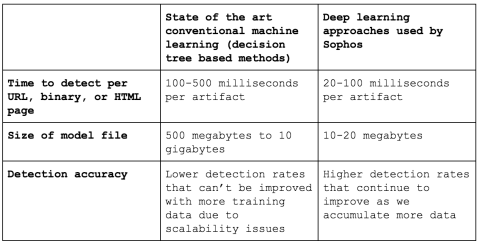
Cyber-security is a fast developing industry. As hackers become more and more sophisticated with all the types of attacks, so too must the protection offered by cyber-security companies. Sophos security is set to unveil their new deep learning technology this fall which will take the company's cyber-security solution to new heights. To understand the magnitude of this protection we will do an introduction to deep learning technology and explain how it works.
Deep Learning Security vs Machine Learning?
To understand deep learning technology let's start with its predecessor, machine learning technology. Machine learning allows the cyber-security solution to see past the disguise of malicious threats and identify threats for what they are.
For example, let's say hackers consistently use a certain type of virus. If the cyber-security solution has been programmed to identify this virus then it will stop it. If the hacker becomes aware that their virus has been identified and stopped by antivirus technology then they may change the virus a little bit so that the antivirus technology doesn't recognize it as a virus. This would allow the virus to penetrate the targeted endpoint and infect the precious data of the user. However, machine learning is able to identify common parts of each virus/threat regardless of their disguise. So if the hacker changes the virus a little bit, the cyber-security solution will still recognize it as a threat and stop it.
There are problems with machine learning. Machine learning doesn't scale well. Machine learning requires your system to know what it is looking for and the systems have to be manually trained to look for it. In order to accomplish this, you'd have to feed millions of files into the system to be analyzed which can significantly slow down the machine learning process.
Enter deep learning security.
Deep learning scales back the human factor of machine learning. Deep learning is the process of running a bunch of known threats through a neural network. The neural network breaks down all of this data and looks at it a lot closer than any human would even be able to process. The initial neurons will identify the most basic parts of the threat. As the threat goes through the deep learning algorithm, the neural network looks at it more and more sophisticated and is able to take the initial findings and expand upon them. Deep learning allows the threats to be fully understood, from the roots to the overall appearance, whether or not this threat is legitimate. Deep learning is able to able to pick up on even the tiniest of details that machine learning simply cannot identify.
Is Deep Learning Scalable?
Unlike machine learning, the more data you punch into the deep learning systems, the smarter it gets. This allows deep learning technology to analyze threats much faster than machine learning, with a smaller footprint, and better detection rates.

Conclusion
A lot of cyber-security companies claim to have the latest and greatest machine learning capabilities. However, Sophos security is lightyears ahead with their investment in deep learning security. Deep learning is right for you if,
1.You want even the most sophisticated malicious threats identified
2. You want a robust and comprehensive cyber-security solution
3. You want better detection rates at a faster speed with a lower footprint.
For more information check out Sophos' introduction to deep learning video:












